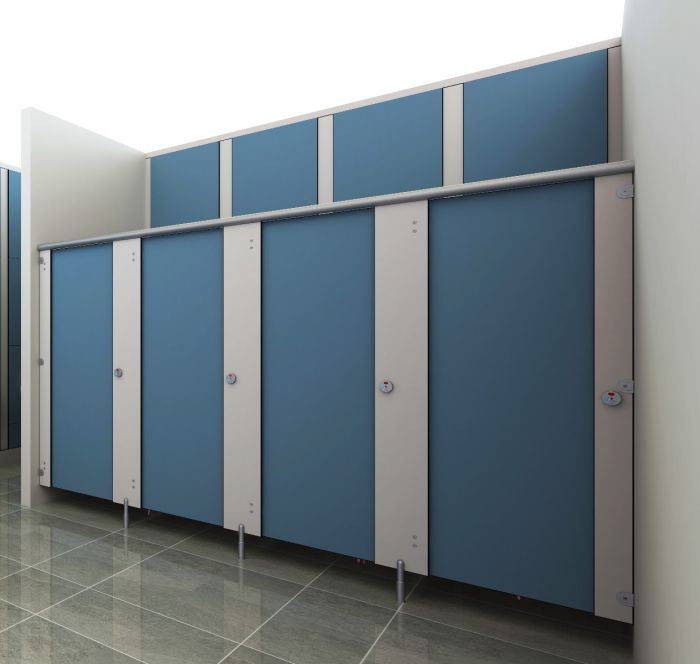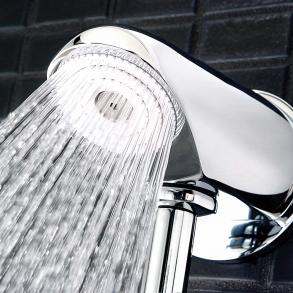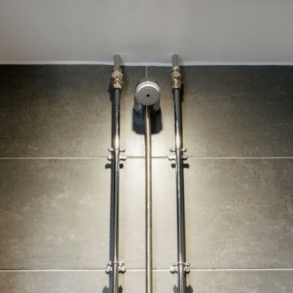Swimming pool changing rooms can be a wet, congested and hazardous environment, prone to significant wear and tear. However, with careful planning and the correct choice of materials, it can benefit from excellent usability, maintenance can be reduced and accidents averted. Here we take a look at some of the things that need to be considered when refurbishing commercial changing rooms.
Flow & Functionality
Good use of space is rarer than you might think and without a considered approach, rookie mistakes can occur. For instance, think about the main door opening to your changing room. You need to make sure that from outside the room, when the door is open or ajar, that the changing area is visible. This is usually a spot for a partition wall, but make sure the partition wall or screen actually does the job intended.
Locker positioning also needs proper planning. Ideally, this needs to be centred between wet and dry areas. Users need to be able to access them when wet, without traipsing their soggy selves all over the changing area.
Materials
In no other washroom environment is material choice more important. This is an area that not only sees heavy footfall, but also a great deal of humidity and water. If the improper materials are used, maintenance can be gruelling and constant, not to mention costly.

First, we need to consider the flooring. In wet areas such as the showering facility, you’re going to need tiles that have excellent non-slip features, which can also withstand hard objects falling on them - you can’t afford to have them chip, crack or shatter in this environment. This same floor covering should run into the toilet and hand wash area and can flow through into the locker and changing areas too. Alternatively, you may choose a ruberised safety flooring as found in hospitals. In some high-end changing rooms, the dry changing area often has a soft, durable carpet.
Toilet, shower and changing cubicles all need to withstand the aforementioned wet environment and for this we unquestionably recommend solid grade laminate (SGL). Made from compounded layers of Kraft papers, the panels are impregnated with resin and are completely impervious to water. This material can be fully customised both in size and colour. SGL will not delaminate like other laminate based cubicle panels and as such, reduces the maintenance and accidental damage risks. Another cubicle material suited to swimming pool changing rooms is our reinforced glass panels. Structured from two laminated sheets of safety glass, they can be frosted or painted inbetween the two sandwiched layers. Again, these panels are completely impervious to water and have reduced maintenance benefits.
Cubicles & Family Changing
Family and unisex changing rooms obviously require changing cubicles. Thought needs to be given to the flow here as it’s not just a case of seeing how many changing cubicles you can cram in to the space. As well as manoeuvring space within the cubicle, you need to plan entry space too.
In family changing rooms, baby-changing stations need to be included within some of the cubicles and you need to think about child seats and playpens. This allows dried and changed infants to be placed somewhere safe while their parent or guardian gets changed themselves. Nappy disposal needs to be easily accessible and to hold significant volume as submerged nappies can swell to quite a size. The knock on effect of this is a bin that becomes full very quickly – especially after a parent and baby swim session.
Extraction and lighting
As with domestic showering and bathroom areas, extraction and air circulation needs to be well thought out. This not only reduces the humidity level in the room, but also helps the room to stay smelling fresh. Lighting will also need careful selection to make sure it won’t short circuit or become damaged after prolonged exposure to steam and moisture.
Showers Noone wants to take a cold shower, or one that’s too hot to use for that matter? Thermostatic mixer valves need to be set properly to prevent scalding and to also make sure the shower is enjoyable. TMV3 valves manage this effectively and are a requirement for some building regulations. In high traffic changing rooms, you may choose to install push taps, which restrict the flow of water for a set period of time. This reduces those instances where showers are absent-mindedly left on and can bring significant savings in water usage. While we are on the subject of showers, make sure your drainage is capable of taking the right amount of water away. In a bank of eight showers, the water needs to flow away much quicker than in a bank of just two.
Noone wants to take a cold shower, or one that’s too hot to use for that matter? Thermostatic mixer valves need to be set properly to prevent scalding and to also make sure the shower is enjoyable. TMV3 valves manage this effectively and are a requirement for some building regulations. In high traffic changing rooms, you may choose to install push taps, which restrict the flow of water for a set period of time. This reduces those instances where showers are absent-mindedly left on and can bring significant savings in water usage. While we are on the subject of showers, make sure your drainage is capable of taking the right amount of water away. In a bank of eight showers, the water needs to flow away much quicker than in a bank of just two.
Sensor activation
Let’s not overlook the toilet and hand wash area. Often, users will be wet from the pool or shower when using these facilities and there are a number of things that can be done to improve usability. Sensor activated flush kits are an excellent addition, as are sensor taps. This removes the need to turn on taps, or deal with the flush operation on toilets. Essentially, this not only makes them easier to use, but also improves hygiene throughout the washroom.
Accessories and dispensers
Great usability not only comes from the correct features and functions, but from the optimum location when siting them. A shampoo dispenser next to the shower is an obvious one, but a nearby towel hook less so. A nearby towel hook that doesn’t get splashed with shower water demonstrates well thought out and successful usability. This is where many other accessories, such as, waste bins, hair dryers, mirrors and child playpens also come into play.
In summary, the swimming pool changing room is an area that needs careful planning and the correct choice of materials. Not only do you need to install the right features, but they need to be located in the best possible way. This will not only make sure your changing rooms flow, but makes sure people enjoy using them.
As always, our team are at the end of the telephone for all your queries and questions and have a wealth of knowledge they’re happy to share with you. So if you need some guidance, or would like to talk over your options, you can give them a call on 01202 650900.




